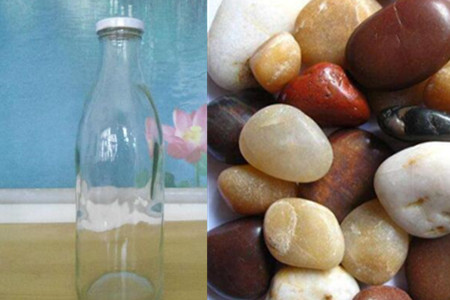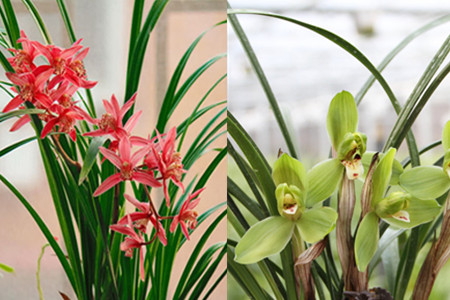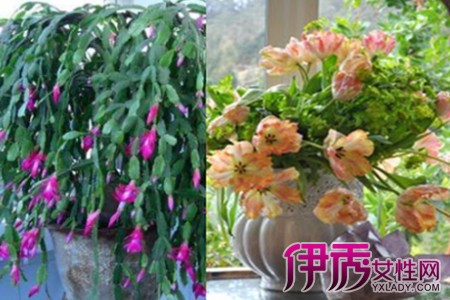Teach you how to raise orchids with empty beverage bottles, a simple tool DIY indoor bonsai without pressure

Cymbidium belongs to the orchid family, which is relatively easy to feed. It is suitable for living in an environment of 15-25 degrees, so it is very good to put it indoors. And the growth rate of Cymbidium is relatively fast and easy to manage, so it can often be seen in many people's homes.
Among them, hydroponic hanging orchids are popular because of their elegant appearance and easy to grow, and the materials needed are also very simple. As long as you use the extra materials around you, you can easily DIY a pot of hydroponic orchids. For example, empty beverage bottles can be used as containers for hydroponic hanging orchids. Here's how to make hydroponic orchids with empty beverage bottles.
First, prepare the materials for DIY.
1. First prepare an empty drink bottle, some pebbles, and a hanging orchid branch.
two。 Remove the top half of the drink bottle with a tool and wash the pebbles. Remove the excess old roots and leaves from the plant.
Second, begin to make hydroponic hanging orchids.
1. If you put water in an empty bottle, you can't put the orchid directly with natural water, because the natural water usually contains bleach and some microbial bacteria, which will affect the growth of the orchid. If you use tap water, it will take about half a day.
two。 Put the washed pebbles into the bottom of the bottle, which can not only improve the ornamental, but also bring good living space to the hanging orchid. After the above steps have been completed, put the orchid into the water.
Third, late management is also very important.
1. After the production of the potted orchid, it is more important to manage it in the later stage. Pay attention to regular change of water, keep the container clean, and it is appropriate to change it every three days.
two。 Wait for the new root to grow out in time to remove the old root, and do not soak all the roots in water, easy to rot roots, put in 2/3. Put the orchid in a place where there is no direct sunlight, and it can grow well.
Appreciation of hanging Orchid Pictures
The function of hanging orchid
According to the research, the hanging orchid has the function of absorbing toxic gases, and there is a pot of hanging orchids in the general room. the formaldehyde emitted by smoking and building materials in the air can be completely absorbed, play a role in purifying the air, and can also play a role in protecting the human body.
The root of Cymbidium and the whole grass can be used as medicine, which has the effects of clearing lung, relieving cough, cooling blood, stopping bleeding and so on. Cymbidium is a perennial herb with slender and drooping branches, small white flowers in summer and yellow stamens, which can be watched in pots.
Appreciation of hanging Orchid Pictures
Dendrobium planting technology, Dendrobium pictures appreciation
Most of the plants of Dendrobium have medicinal properties, such as the famous Dendrobium candidum and Dendrobium nobile, but they also have ornamental value. Dendrobium is divided into two kinds, one is spring Dendrobium, which blossoms in spring, and the other is autumn Dendrobium, which blossoms in autumn. Cultivation should be treated separately according to the difference between the two.
Dendrobium planting technology, Dendrobium pictures appreciation-
[plant archives]-
English name: Dendrobium
Scientific name: Dendrobium nobile
Aliases: Dendrobium, Magnolia, Orchid, Dendrobium nobile, Fengdou
Family: Orchid Orchidaceae
Genus: Dendrobium of Dendrobium
Distribution: distributed in various ecological environments such as Asia, Taiwan, Philippines, Borneo, Australia, New Guinea and New Zealand.
Morphological features: stem erect, fleshy, slightly flattened cylindrical, upper more or less folded, base obviously narrowed, unbranched, with many nodes; flowers large, white with lavender apex, sometimes all purplish red or white except for a purplish red patch on the labial disc, the rest are white; florescence April-May.
Planting technique of Dendrobium
● pot cultivation of Dendrobium requires light, well-drained and breathable substrates such as fern root, peat moss, bark and charcoal. In order to facilitate the development of root system, there are many tiles or broken bricks at the bottom of the basin. The cultivation environment with sufficient light is more beneficial to the growth and flowering of Dendrobium. Spring and summer are the growing period of Dendrobium, and full watering can accelerate the growth of pseudocorm. Reduce watering after September, so that the pseudo-corm tends to mature, which can promote flowering.
● Dendrobium was fertilized once every ten days during the growing period, decreased in autumn, and stopped completely in the mature stage and winter dormancy period of pseudocorm. The root system of Dendrobium which has been cultivated for more than 2-3 years is full, so the pot should be changed in time. No matter evergreen or deciduous Dendrobium, the pots are changed after flowering. Pay attention to less damage to the root when changing the basin, otherwise the leaves will be yellowed and fall off in case of low temperature.
● Dendrobium is often propagated by ramet, cuttage and tissue culture.
① ramet propagation
The combination of changing pots in spring. The mother plant with dense growth will be held out from the basin, the roots and leaves will be less hurt, the orchid seedlings will be gently broken, and 3-4 plants will be planted in 15cm pots, which is beneficial to shaping and flowering.
② cuttage propagation
Select the false bulb that grows and enrich without flowering, cut it from the rhizosphere, cut it into every 2-3 segments, insert it directly into the peat moss or wrap the base of the cuttings with water moss, keep it moist, take root at room temperature at 18-22 ℃, and take root at 30-40 days after insertion. Potted plants with roots 3 to 5 cm long.
Dendrobium ● is often harmed by black spot and virus disease. It can be sprayed with 1000 times of acetic acid solution. Insect pests are harmful to shell insects and are sprayed with 2000 times of omethoate EC. Prevention and control methods:
① Clean Orchid Garden: a small number of diseased leaves in the orchid garden should be cut off and the fallen leaves in winter should be collected and burned.
② greenhouse environmental management: the temperature in the greenhouse is often as high as 40 ℃ in summer, which should be ventilated and cooled to avoid poor growth of orchid plants. During the low temperature period in winter, the water supply should be sunny and sunny at noon, and some plastic sheets should be opened to increase ventilation in order to reduce indoor relative humidity.
[more Encyclopedia of plants]
Tequila, canna, other flowers, forget-me-not dandelions, Dendrobium candidum, Taxus, kapok, cotton, sweet-scented osmanthus and sea crabapple flowers.
Home fengshui plant bedroom fengshui plant plum blossom aloe jasmine radiation protection plant potted plant potted plant drug plant
Mistletoe indoor flower rich tree evergreen potted production of red palm mint stone flower geranium garden crab claw orchid plain sailing
- Prev

The cultivation of orchids in Yunnan should pay attention to four aspects to make it grow more beautiful and flourish.
Orchid, in the hearts of the Chinese people, has almost reached the point of personalizing it. Take it as elegant and noble, and use it to praise beautiful things and people. With its distant fragrance and beautiful leaf posture, the orchid conquers generations of flower lovers.
- Next

Learn how to grow indoor flowering plants to make the room second change garden kingdom
Compared to some green plants, most people still prefer to keep a few pots of flowering flowers at home. Flowers of all colors bloom together to make people feel like they are in a garden, so today we are going to tell you how to raise indoor flowering plants.
Related
- Fuxing push coffee new agricultural production and marketing class: lack of small-scale processing plants
- Jujube rice field leisure farm deep ploughing Yilan for five years to create a space for organic food and play
- Nongyu Farm-A trial of organic papaya for brave women with advanced technology
- Four points for attention in the prevention and control of diseases and insect pests of edible fungi
- How to add nutrient solution to Edible Fungi
- Is there any good way to control edible fungus mites?
- Open Inoculation Technology of Edible Fungi
- Is there any clever way to use fertilizer for edible fungus in winter?
- What agents are used to kill the pathogens of edible fungi in the mushroom shed?
- Rapid drying of Edible Fungi

